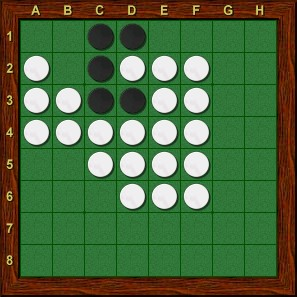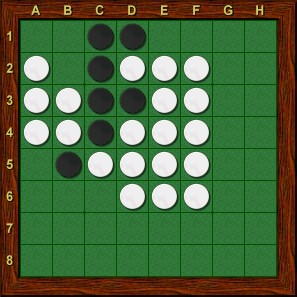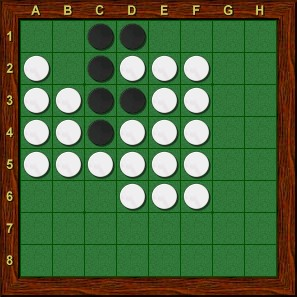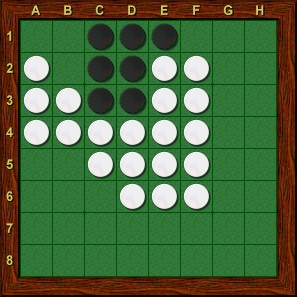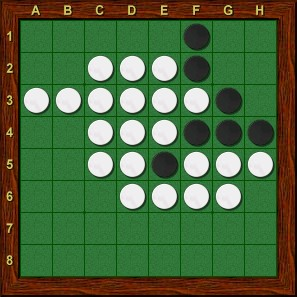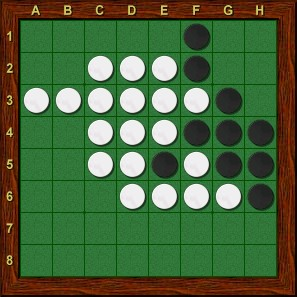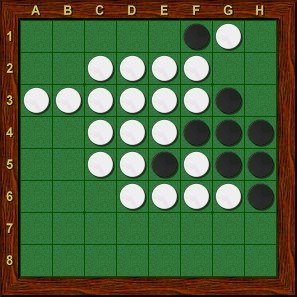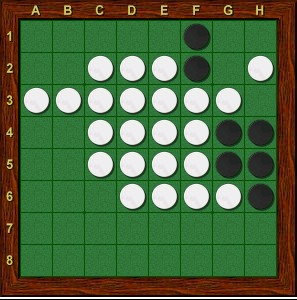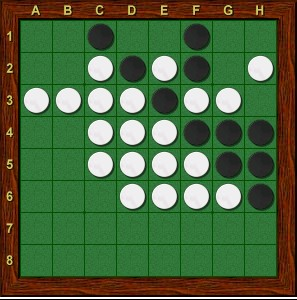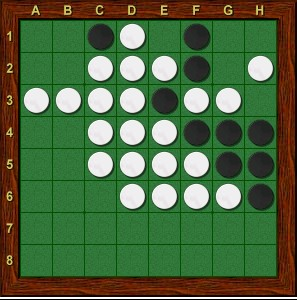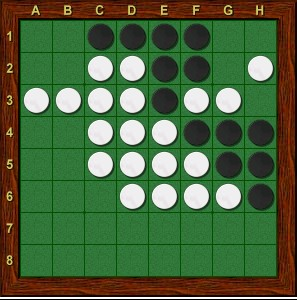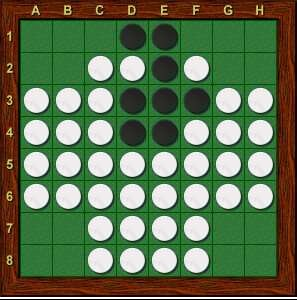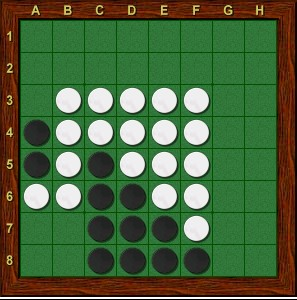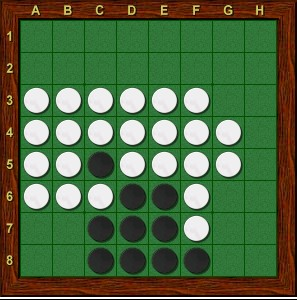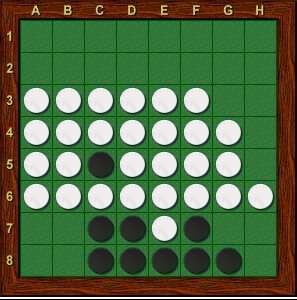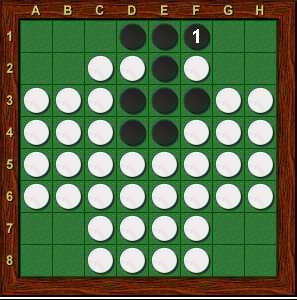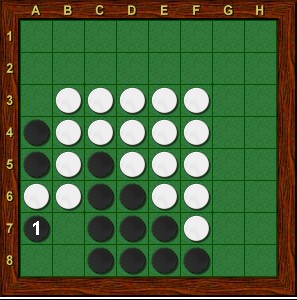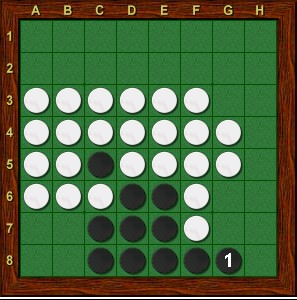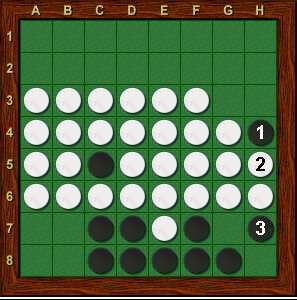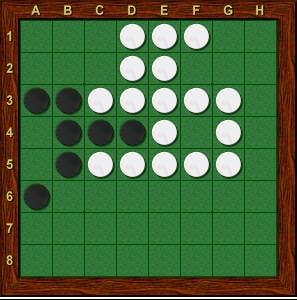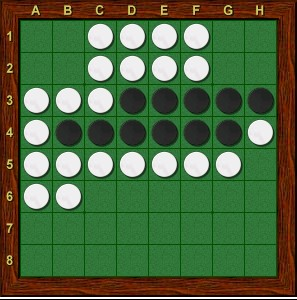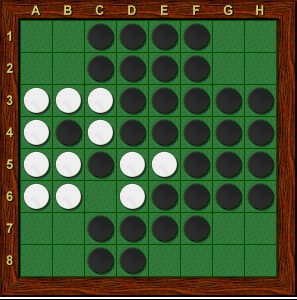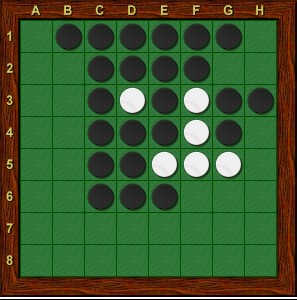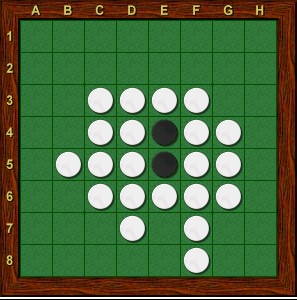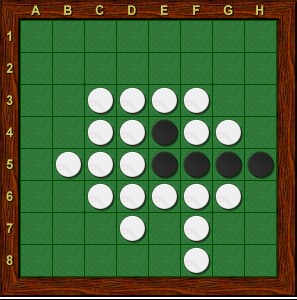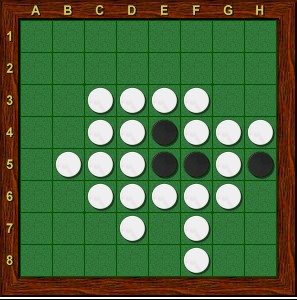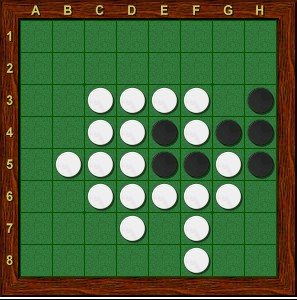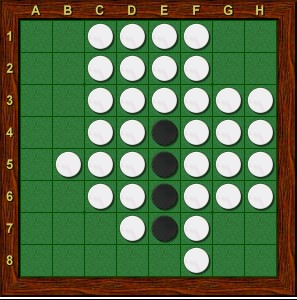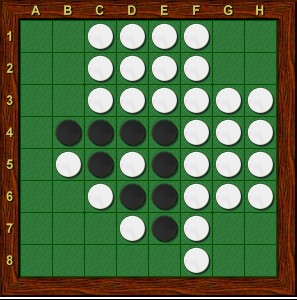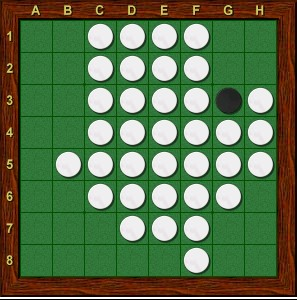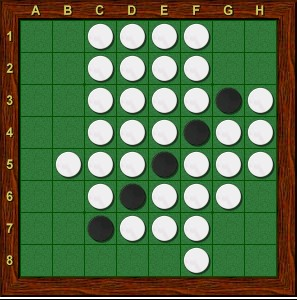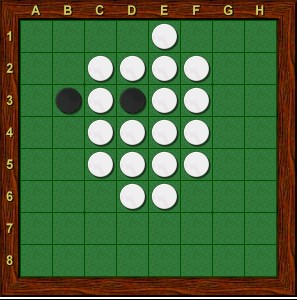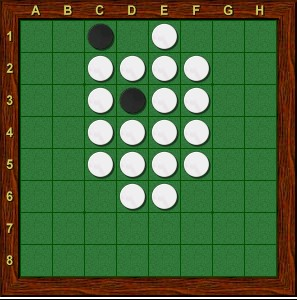Fang: Weitere Othello Konzepte
| Click here for English Version | |
| Navigation: Hauptseite > Othello lernen > Buch Fang | << voriges Kapitel << - >> nächstes Kapitel >> |
Greed is One of the Seven Deadly Sins
In the last section, I talked about the importance of corners. Obviously, corners aren’t available at the beginning of the game. What you really want to know next is: what other rules can I follow during the rest of the game so that I have a chance at beating more than just beginners? If you followed my advice and played a few games with some beginning and intermediate players, you may have started to notice a pattern.
Let’s take a look at a sample position:
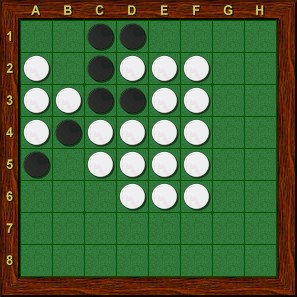
|
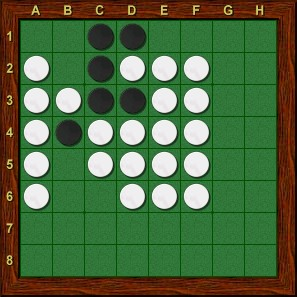
|
This also doesn’t accomplish much. Unfortunately for white, black has a much better move here,E1. After E1, white STILL has the same 2 moves that lose the corner. |
| BLACK PLAYS A5 | WHITE PLAYS A6 |
What can we learn from the above position? With good play, you can force your opponent to give you corners – even if they’ve discovered how valuable corners are and they are also avoiding playing into X-squares and C-squares. The real question is: how do you get into positions where your opponent will have to give you a corner?
Let’s take a look at another example:
| H3 might appear good, but after H3 black can play H2 and white will be forced to play G2 or G1 – both of which lose the corner. | 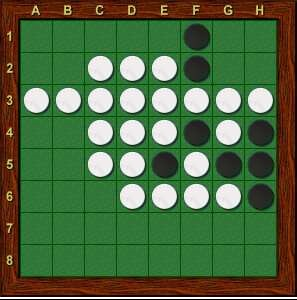
|
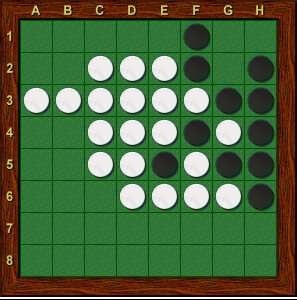
|
| IF WHITE PLAYS H3 | BLACK PLAYS H2 |
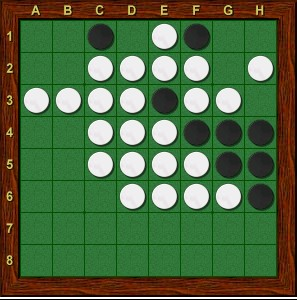
|
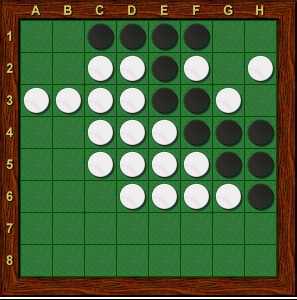
| |
| IF WHITE PLAYS E1 | BLACK PLAYS D1 |
So if it’s black’s turn, white will lose. What about if it’s white’s turn? White could play H3 ,making a black move to H6 pointless (White just plays H7 after H6), however then black will just play E1 instead, forcing white to play D1 and then black will play C1 forcing white to lose a corner.
Obviously, whatever it is about the previous starting positions that is bad, it carries over no matter whose turn it is. In order to figure out how to force our opponents to give us corners, we need to figure out what features the two diagrammed positions have in common. White’s real problem in both positions is that he doesn’t really have a lot of options to begin with and the options that he has aren’t very good. When you have lots of moves to choose from you are said to “have lots of mobility”. When you don’t have many moves to choose from you are “low on mobility”. Having good mobility(having good moves) is a very important part of the game. If you have a lot of mobility – at least a few of those moves are bound to be good. And the opposite is true, if you don’t have very many moves – you might not have any good moves at all.
Many games between an expert and a beginner are decided in terms of mobility alone. The expert quickly runs the beginner out of good moves, and then forces the beginner to give up a corner (by leaving the beginner one or two moves that both lose a corner) and from there it’s all a matter of technique.
Why doesn’t white have much mobility in the above diagrams? Because black doesn’t have a lot of disks., Obviously if black only has 3 or 4 disks, white will probably have only 2 or 3 moves. If those 2 or 3 moves are all moves that give away a corner, then black is probably going to win. The point I’m trying to make here is that by having fewer disks, you can get into positions where your opponent is forced to give you a corner. Having fewer disks is actually better most of the time!
Unfortunately, this can be a very difficult lesson to learn. The “goal” of the game is to get the most disks, right? Wrong. The goal of the game is to have the most disks at the end of the game. We’ve already seen how having corners leads to stable disks and we know that stable disks lead to more disks at the end of the game. In between the start and the end of the game, our goal is to put ourselves into a position where we’re likely to have the most disks at the end of the game. If this means having fewer disks in the opening and midgame, then so be it.
Exercises:
| Now that we’ve seen a little bit about how we can force our opponents to give us a corner – these exercises will help us find the killer moves that are necessary to get the job done. Find a move or short sequence that forces your opponent to give you a corner. Note that in most of these positions there are multiple answers. I’ve picked the shortest killer sequence as the answers. If you found another forced sequence, good job! | 1. | 2. |
| Black To Play | Black To Play |
| 3. | 4. | |
| Black To Play | Black To Play |
Answers:
| 1. | 2. |
| 3. | 4. |
Exercises:
| Find the Perfectly Quiet Move in each of the following positions: | 1. | 2. |
| BLACK TO PLAY | BLACK TO PLAY |
| 3. | 4. | |
| BLACK OR WHITE TO PLAY | WHITE TO PLAY |
Answers:
1. F4 2. H5 3. C6 is a Perfectly Quiet Move for BOTH players 4. H4
Don’t leave yourself high and dry
Let’s say that your opponent is trying to maximize their disks. At some point in the game, you’re likely to get wiped out if you completely commit yourself to minimizing your disks. The term for this situation is overevaporation. Unfortunately, you can’t always focus on just minimizing your disks,you sometimes have to pay attention to make sure that you’re not going to wipe out. Remember having fewer disks is a means to forcing your opponent to give you corners, it is not an end in and of itself.
In order to avoid being wiped out by someone who is playing greedily, you’ll want to try to play moves that do 1 of 3 things (in this order of importance):
- Establish a stronghold on an edge that your opponent can’t flip
- Play a move that flips disks in more than one direction at once
- Play a move that makes a line that is not immediately reflippable.
Let’s take a look at examples of each of these in turn.
Establish a stronghold on an edge that your opponent can’t flip
Edge disks are harder to flip than regular disks as they can only be flipped by other disks on the edge, instead of in 8 different ways like all the other disks. By establishing a stronghold on the edge and not letting your opponent flip those disks, you guarantee yourself that you’ll have some disks to play off of later in the game.
Flip in more than one direction at once
If you are dangerously low on disks, flipping more disks will help you avoid being wiped out. That is one of the reasons that flipping in more than one direction at once is good. You tend to flip more disks when you flip in more than one direction. Also, your opponent can never wipe you out on the move immediately following a move in which you’ve flipped in more than one direction.
Make a line that is not immediately reflippable
Obviously if a line is not immediately reflippable then your opponent can’t wipe you out on the next move. Making a non-reflippable line is usually a delaying tactic that you will use until you can play moves that meet one of the two above criteria.
What’s in an edge
Let’s take a look at another position and see what we can learn from it:
Let’s play fantasy Othello for a bit and move one disk on the board slightly
Another thing that you should notice is that in the original diagram, the black disk is on the outside of the mass of white disks where it could be flipped – which means that white has a couple of possible moves to begin with. Disks that are on the outside of a mass of opposite colored disks that can be flipped are called frontier disks. The edge disk in the second example isn’t a frontier disk at the current time because it can’t be flipped. In the future, white may get a disk at D1 or black could play to D1 in which case C1 would become a frontier disk. Since every frontier disk provides your opponent with a potential move, having,fewer frontier disks mean that you have a better position.
Now that I’ve set some general guidelines, we’ll spend the next few chapters exploring the three phases of the game: the opening, the midgame, and the endgame. We’ll look at how to apply these guidelines to the three phases of the game as well as when these guidelines no longer apply.
| Navigation: Hauptseite > Othello lernen > Buch Fang | << voriges Kapitel << - >> nächstes Kapitel >> |
